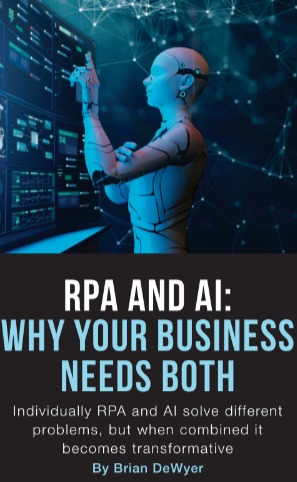Originally Posted in Document Strategy Magazine
Today, executives are excited about AI’s potential to help their businesses grow and innovate. AI could potentially transform every part of work, delight customers with new experiences, and increase employee productivity.
In fact, enterprises for the past decade have been investing in a new automation strategy fueled by Robotic Process Automation (RPA), a low code / no code approach to automating repetitive and rule-based tasks by integrating software bots easily within existing human work patterns.
Artificial Intelligence (AI), on the other hand, has captured most of our attention in the last few years, given AI’s business impact on organizations. A new wave of generative AI has again excited leadership and, at the same time, cautiously looked at ways AI can be utilized in different facets of the business.
It is not surprising given AI encompasses a broader range of technologies, including machine learning, natural language processing (NLP), and computer vision that take intelligent automation to the next level going well beyond what RPA bots can perform. In fact, Gartner research states “90% of robotic process automation (RPA) vendors will offer generative-AI-assisted automation by 2025” – Gartner: Magic Quadrant for Robotic Process Automation.
We could draw distinct lines into an AI vs. RPA side-by-side comparison, showing the pros and cons, but that viewpoint is very limiting and constrains the potential combined value.
The best approach is an open discussion on the investments enterprises have made into RPA, redefining the work between humans and machines, and detailing a multi-year strategic plan outlining corporate business goals and combining technologies to deliver the biggest impact to the business.
Unstructured Data: Core to the Workplace
If we consider all how bots are used today, everything from manipulating and inputting data into systems – ERP, CRM, ECM, EHR, and more –accessing and moving financial data between systems and spreadsheets, or creating a better onboarding experience for employees and customers, software bots have proven technically powerful at delivering significant business impact with quicker time to value. Early on, enterprises laid the foundation, making sure their RPA strategy covered all the bases, from identifying the right use cases, design, and implementation to planning how they would scale and support the deployment of thousands of bots.
RPA failed early on when organizations attempted to use bots to handle processes involving highly unstructured data, especially document extraction.
Enterprise RPA strategies quickly adapted and started to include intelligent document processing (IDP), which could handle the processing of unstructured data from images, PDFs, and emails. Business processes like AP automation, legal contract reviews, supply chain logistics, and onboarding employees or customers were ripe for new technology and approaches to automation. IDP proved to be the next key pillar to a digital transformation strategy, giving intelligent automation teams the technology they needed to read, extract, and organize meaningful information from all documents.
At its core, IDP is all about AI, specifically the historical use of optical character recognition (OCR), natural language processing (NLP), and machine learning technologies. This natural progression of RPA into processing unstructured data meant IDP solutions would follow the same path as RPA, introducing low-code/no-code offerings that utilized machine learning and introduced pre-trained models to understand documents right out of the box. This exposed enterprise automation teams to AI but did not require individuals to have deep domain expertise with AI skills.
RPA Remains Relevant as use of AI Evolves
The ability to process unstructured data is a key measurement of how relevant RPA use is today. RPA’s ability to automate simple tasks and processes and combine them with AI to incorporate understanding and learning capabilities has continued to make RPA platforms relevant, especially when it involves document processes.
Still, some may be skeptical about whether RPA platforms can truly remain relevant as part of an enterprise automation strategy. RPA will likely retain its relevancy given that the technology provides key support functionality to make AI work more smoothly, including cleansing AI data, bridging gaps with legacy systems, incorporating humans into the process, performing simple tasks where AI is not required, and even monitoring activities involving AI.
Next Wave: AI Agents
With the latest wave of AI embracing generative AI (GenAI) and large language models (LLM), the combined RPA and AI approach offers great promise to advancing AI agents, ones that act on behalf of an individual, making rational decisions based on data and are always learning to produce optimal results and performance. The potential benefits are unlimited when we consider an AI agent could engage with employees and customers and participate in critical business decisions just like humans do.
Consider common use cases like analyzing and auditing financial documents, understanding insurance claims and underwriting reports, or summarizing and comparing legal contracts. These types of document processes are extraordinarily complex data-driven tasks that rely on complex data structures in documents, but GenAI now opens the door to quicker implementation and more accurate information.
The RPA platform provides a solid foundation for these AI agents by using the RPA platform architectures designed to operate thousands of bot automation. This will be necessary as humans and AI agents work independently or together. Consider an intelligent document process that could extract the data from a set of documents, and then humans step in to review and interact with the information to derive additional insight from the data.
The pace at which GenAI is moving is incredibly fast. What was not possible a year ago is now possible today, and six months from now, we will be having a new conversation. One of the biggest challenges to GenAI is ensuring trust and data security around the services. This is a similar challenge that RPA platforms face when managing human credentials that bots use to access systems. GenAI takes the challenge to an entirely new level, where we can imagine that the oversight of these AI agents will require knowing what systems and data were used by the AI agents or monitoring behavioral changes that occur in responses to data. Effective application management of a dynamic digital workforce growing in complexity will be required to provide oversight of not just the RPA and AI micro-automation but all the systems and data being accessed and processed.
RPA and AI: Better Together.
The business benefits achieved from the combination of AI and RPA are solid. Individually, RPA and AI solve different problems, but when combined, it becomes transformative. In particular, the strengths perform well when automating complex unstructured document processes (hard-to-reach data), an area where there is no shortage of opportunity and business upside to automating the extraction of data that drives insight and better business decisions. Furthermore, the solid platform foundation by which RPA comes to automate existing work patterns through UI integration quickly has a tremendous upside for AI agents, who also require access to vast amounts of information to perform more advanced cognitive tasks.



0 Comments